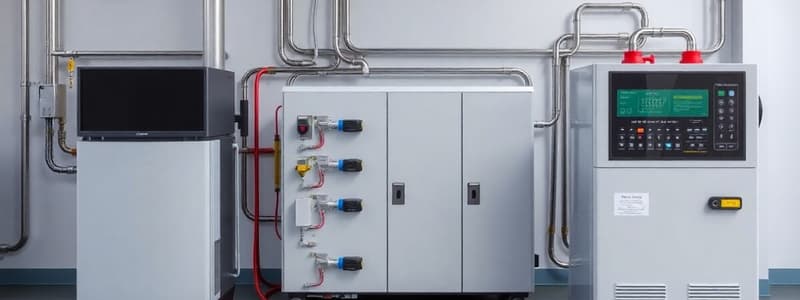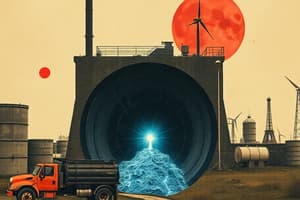Podcast
Questions and Answers
What is the energy density of hydrogen?
What is the energy density of hydrogen?
- 15 kWh/kg
- 50 kWh/kg
- 33 kWh/kg (correct)
- 25 kWh/kg
Why is hydrogen considered a clean fuel during use?
Why is hydrogen considered a clean fuel during use?
- It can be generated from fossil fuels.
- It releases sulfur compounds.
- It produces carbon emissions.
- It only releases water vapor. (correct)
What is one of the main challenges in storing hydrogen?
What is one of the main challenges in storing hydrogen?
- Low weight density (correct)
- High environmental impact
- High energy content
- Expensive production methods
Which method is NOT a technique for reducing the volume of hydrogen?
Which method is NOT a technique for reducing the volume of hydrogen?
What percentage of the energy content is needed to compress hydrogen?
What percentage of the energy content is needed to compress hydrogen?
Why is the production of hydrogen currently considered unsustainable?
Why is the production of hydrogen currently considered unsustainable?
Which hydrogen storage method requires cooling to -253°C?
Which hydrogen storage method requires cooling to -253°C?
How much more energy does hydrogen contain compared to diesel fuel?
How much more energy does hydrogen contain compared to diesel fuel?
What is one common type of hydrogen chemical storage?
What is one common type of hydrogen chemical storage?
Which color of hydrogen indicates it is produced using renewable energy sources?
Which color of hydrogen indicates it is produced using renewable energy sources?
What process is typically used to produce 50% of hydrogen worldwide?
What process is typically used to produce 50% of hydrogen worldwide?
What is a major disadvantage of the electrolysis of water for hydrogen production?
What is a major disadvantage of the electrolysis of water for hydrogen production?
Which components are necessary in a power-to-power storage system based on hydrogen?
Which components are necessary in a power-to-power storage system based on hydrogen?
What is a necessary condition for the hydrogenation process?
What is a necessary condition for the hydrogenation process?
What does the color blue represent in hydrogen production?
What does the color blue represent in hydrogen production?
Which component is NOT a part of the hydrogen energy storage system as described?
Which component is NOT a part of the hydrogen energy storage system as described?
What is the primary purpose of an electrolyzer?
What is the primary purpose of an electrolyzer?
What is the energy efficiency range of alkaline electrolysis (AE)?
What is the energy efficiency range of alkaline electrolysis (AE)?
At what temperature range does alkaline electrolysis typically operate?
At what temperature range does alkaline electrolysis typically operate?
What type of membrane is used in proton exchange membrane (PEM) electrolysis?
What type of membrane is used in proton exchange membrane (PEM) electrolysis?
How much electric power is typically required for PEM electrolysis to produce hydrogen?
How much electric power is typically required for PEM electrolysis to produce hydrogen?
Which method of electrolysis has the highest energy efficiency?
Which method of electrolysis has the highest energy efficiency?
What is the typical temperature range for solid oxide electrolysis (SOE)?
What is the typical temperature range for solid oxide electrolysis (SOE)?
Which water electrolyzer type produces gases with a purity of 99.99%?
Which water electrolyzer type produces gases with a purity of 99.99%?
Flashcards
Hydrogen: Clean Fuel
Hydrogen: Clean Fuel
Hydrogen is a clean fuel that produces zero emissions during use (except for water vapor) when generated by renewable energy sources.
Hydrogen: Energy Density
Hydrogen: Energy Density
The energy content of hydrogen is significantly higher than diesel fuel and natural gas, making it a promising candidate for long-term energy storage.
Hydrogen: Production & Conversion
Hydrogen: Production & Conversion
Hydrogen can be produced from electricity using electrolysis, and the reverse process, converting hydrogen back to electricity, is achieved through fuel cells.
Hydrogen: Storage Challenges
Hydrogen: Storage Challenges
Signup and view all the flashcards
Hydrogen Storage: Compression
Hydrogen Storage: Compression
Signup and view all the flashcards
Hydrogen Storage: Liquefaction
Hydrogen Storage: Liquefaction
Signup and view all the flashcards
Hydrogen Storage: Solid Storage
Hydrogen Storage: Solid Storage
Signup and view all the flashcards
Sustainable Hydrogen Production
Sustainable Hydrogen Production
Signup and view all the flashcards
Metal Hydrides
Metal Hydrides
Signup and view all the flashcards
Electrolysis of Water
Electrolysis of Water
Signup and view all the flashcards
Reforming of Natural Gas
Reforming of Natural Gas
Signup and view all the flashcards
Green Hydrogen
Green Hydrogen
Signup and view all the flashcards
Blue Hydrogen
Blue Hydrogen
Signup and view all the flashcards
Carbon Capture and Storage (CCS)
Carbon Capture and Storage (CCS)
Signup and view all the flashcards
Power-to-Power Storage System
Power-to-Power Storage System
Signup and view all the flashcards
Fuel Cell
Fuel Cell
Signup and view all the flashcards
What is electrolysis of water used for?
What is electrolysis of water used for?
Signup and view all the flashcards
What is an electrolyzer?
What is an electrolyzer?
Signup and view all the flashcards
What are the components of an electrolyzer?
What are the components of an electrolyzer?
Signup and view all the flashcards
What is Alkaline Electrolysis (AE)?
What is Alkaline Electrolysis (AE)?
Signup and view all the flashcards
What is Proton Exchange Membrane (PEM) electrolysis?
What is Proton Exchange Membrane (PEM) electrolysis?
Signup and view all the flashcards
What is Solid Oxide Electrolysis (SOE)?
What is Solid Oxide Electrolysis (SOE)?
Signup and view all the flashcards
What are the main types of water electrolyzers?
What are the main types of water electrolyzers?
Signup and view all the flashcards
Study Notes
Energy Storage Systems
- Energy storage using hydrogen is a promising technology due to its high energy density (33 kWh/kg). It is a good candidate for mid and long-term storage, especially for seasonal storage in renewable energy sources (RES).
- Hydrogen has significantly higher energy content than diesel (3 times more) and natural gas (2.5 times more).
- Hydrogen can be produced from electricity using electrolyzers and converted back into electricity using fuel cells.
- Storing hydrogen is challenging due to its low weight density, requiring a large storage volume (11 m³ for 1 kg).
- Hydrogen is typically compressed at high pressure (350-700 bar).
- Hydrogen is suitable for long-distance transmission.
- Hydrogen is considered a clean fuel, producing zero emissions during use (except for water vapor), if generated by renewable sources. However, current production methods are not always sustainable, often relying on fossil fuels. A future approach uses water electrolysis powered by RES.
- Current hydrogen production is significantly more expensive compared to fossil fuels.
Energy Densities
- The presentation includes a figure showing energy densities of various energy carriers, including hydrogen, natural gas, propane, diesel, and ethanol.
- A typical lithium-ion battery has a much lower energy density (only 0.15 kWh/kg).
Hydrogen Storage Methods
- Three main ways to store hydrogen to reduce its volume:
- Compressed gas (350-700 bar)
- Liquid phase (-253°C)
- Solid form (metallic hydride) or chemical form (e.g., MgH₂)
- Compressing hydrogen to high pressure requires energy which accounts for 10-15% of its energy content.
- Liquid hydrogen requires significant energy to bring it to the low temperatures for storage.
- Metal hydrides are common storage methods, capable of high storage densities exceeding liquid hydrogen, but require higher temperatures and pressures.
Hydrogen Production Methods and Sources
- A diagram shows that various renewable energy sources (wind, solar PV, hydro, geothermal, and biomass) can power hydrogen production via electrolysis.
- Fossil fuels (oil, gas, coal) are also involved in hydrogen production through reformation/gasification methods.
Global Hydrogen Production
- A table presents global hydrogen production by different sources and categorized with their shares, advantages, and disadvantages.
- Natural gas is the leading producer with around 48%.
- Oil, coal, and electrolysis are the other sources.
- Main sources have low production cost but may have environmental impacts (e.g., greenhouse gas emissions).
- Electrolysis can be a sustainable technology with low emissions.
Hydrogen Applications
- Hydrogen is used in various applications, including ammonia production, oil refining, and methanol production.
- The graph illustrates the increase in H₂ demand from 1950 to 2020.
Hydrogen Color
- Different colors representing different categories of hydrogen production:
- Grey: Polluting process (fossil fuel based)
- Blue: Partially fossil fuel based with carbon capture and storage
- Green: Using renewable energy sources.
Power-to-Power Storage System
- A figure illustrates a hydrogen-based power-to-power storage system involving an electrolyzer, hydrogen storage, and a fuel cell.
- Intermediate processes (such as hydrogen and oxygen conditioning) are necessary to improve energy density.
- Both hydrogen and oxygen storage reservoirs are shown.
Electrolysis of Water
- Around 50% of hydrogen is produced from fossil fuel reformation.
- Electrolysis is a more expensive process for hydrogen production, but it is becoming increasingly important.
- Electrolysis involves water decomposition into hydrogen and oxygen through the use of an electric current.
- Different technologies exist, each with varying efficiency and temperature requirements, including Alkaline Electrolysis (AE), Proton Exchange Membrane (PEM), and Solid Oxide Electrolysis.
Types of Water Electrolyzers
- Alkaline Electrolysis (AE): Well-established with 70-80% efficiency and moderate temperatures.
- Proton Exchange Membrane (PEM): High production rate and high purity, efficiency of 80-90% with lower operating temperatures.
- Solid Oxide Electrolysis (SOE): High energy efficiency (90-100%) but operates at high temperatures, 500-850° C, consuming 3.2 kWh/m³ of hydrogen.
Fuel Cell Generation
- The figure illustrates how a fuel cell operates, converting hydrogen and oxygen into water, electricity, and heat.
Studying That Suits You
Use AI to generate personalized quizzes and flashcards to suit your learning preferences.




